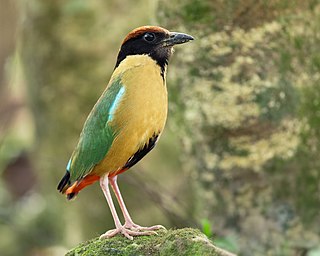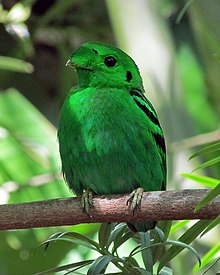
A passerine is any bird of the order Passeriformes, which includes more than half of all bird species. Sometimes known as perching birds, passerines generally have an anisodactyl arrangement of their toes, which facilitates perching.

Picinae containing the true woodpeckers is one of four subfamilies that make up the woodpecker family Picidae. True woodpeckers are found over much of the world, but do not occur in Madagascar or Australasia.

Laridae is a family of seabirds in the order Charadriiformes that includes the gulls, terns, noddies, skimmers, and kittiwakes. It includes around 100 species arranged into 22 genera. They are an adaptable group of mostly aerial birds found worldwide.

The Old World flycatchers are a large family, the Muscicapidae, of small passerine birds restricted to the Old World, with the exception of several vagrants and two species, bluethroat and northern wheatear, found also in North America. These are mainly small arboreal insectivores, many of which, as the name implies, take their prey on the wing. The family includes 352 species and is divided into 53 genera.

The gnateaters are a bird family, Conopophagidae, consisting of twelve small suboscine passerine species in two genera, which occur in South and Central America.

Pittas are a family, Pittidae, of passerine birds found in Asia, Australasia and Africa. There are 44 species of pittas, all similar in general appearance and habits. The pittas are Old World suboscines, and their closest relatives among other birds are in the genera Smithornis and Calyptomena. Initially placed in a single genus, as of 2009 they have been split into three genera: Pitta, Erythropitta and Hydrornis. Pittas are medium-sized by passerine standards, at 15 to 25 cm (5.9–9.8 in) in length, and stocky, with strong, longish legs and long feet. They have very short tails and stout, slightly decurved bills. Many have brightly coloured plumage.

The Eurylaimidae are a family of suboscine passerine birds that occur from the eastern Himalayas to Indonesia and the Philippines. The family previously included the sapayoa from the Neotropics, the asities from Madagascar, and the Calyptomenidae from Africa and Asia, but these are now separated into distinct families.

The asities are a family of birds, Philepittidae, that are endemic to Madagascar. The asities consist of four species in two genera. The Neodrepanis species are known as sunbird-asities and were formerly known as false sunbirds.

The long-tailed broadbill is a species of bird that is found in the Himalayas, extending east through Northeastern India to Southeast Asia. It is the only bird in the genus Psarisomus. The long-tailed broadbill is about 25 cm (10 inches) in length and weighs between 50 and 60 grams. It can be identified by its shrill call.

Pitta is a genus of birds in the Pittidae, or pitta family. They are secretive, brightly coloured birds that forage on the forest floor. They are long-legged and short-tailed with rounded wings. They all have green on their upperparts with blue wing-patches. Many have dark heads. Nest construction, incubation and rearing of nestlings is performed by both parents. Incubation is completed in some 17 days, and the nestlings are altricial and nidicolous. Some species are migratory.

Hose's broadbill is a species of bird in the family Calyptomenidae. It was described by the British naturalist Richard Bowdler Sharpe in 1892 and is named after the British zoologist Charles Hose, who collected the holotype of the species. It is 19–21 cm (7.5–8.3 in) long, with females weighing 92 g (3.2 oz) on average and males weighing 102–115 g (3.6–4.1 oz). Males are bright green and have conspicuous black spots on the wings, black markings on the head, blue underparts, black flight feathers, and a large green tuft covering most of the bill. Females have smaller forehead tufts, lime-green underparts with sky blue instead of azure blue on the undertail coverts, and lack black markings on the head, except for a black spot in front of the eye.

Whitehead's broadbill is a species of bird in the family Calyptomenidae. It is endemic to the mountain ranges of north-central Borneo, where it mainly inhabits montane forests and forest edges at elevations of 900–1,700 m (3,000–5,600 ft). It is 24–27 cm (9.4–10.6 in) long, with males weighing 142–171 g (5.0–6.0 oz) and females weighing 150–163 g (5.3–5.7 oz). Males are vivid green and have a black throat patch, black spots on the ear-coverts and back of the neck, and black markings and streaking all over the body. The tails and flight feathers are also blackish. Females are smaller and lack the black markings on the head and underparts. Juveniles look similar to adults but have fewer black markings.

The dusky broadbill is a species of bird in the family Eurylaimidae, the broadbills. It is native to Southeast Asia. It may be slowly declining due to habitat loss, especially from logging, but it has a large enough range that it is still considered to be a least-concern species.

The black-and-red broadbill is a species of bird in the typical broadbill family, Eurylaimidae. It is the only species in the genus Cymbirhynchus. A large, distinctive bird, it has maroon underparts, black upperparts, a maroon neck-band, and white bars on the wings. It also has a large, two-colored, blue-and-yellow bill. The species shows slight sexual dimorphism, with females being smaller than males. No other bird in its range resembles it, though the black-and-yellow broadbill has a similar call.

The banded broadbill is a species of bird in the typical broadbill family Eurylaimidae found in Mainland Southeast Asia and the Greater Sunda Islands. It is sometimes split into two species, one including only the nominate subspecies, E. j. javanicus, and one including all the remaining subspecies. It inhabits a variety of forests, along with forest edge, rubber plantations and Falcataria falcata groves, mainly in lowland areas. A striking, large-bodied bird with a length of 21.5–23.0 cm (8.5–9.1 in), it is unlikely to be mistaken for another species. The broadbill is mostly purplish-red, with yellow-streaked black wings, a bright blue beak, a blackish face and greyish chin and upper breast. Females can be told apart from males by their lack of a black neckband, although these are indistinct in Bornean and Javan males. Despite its conspicuous appearance, the bird is usually hard to see due to its sluggishness and is usually only noticed when it vocalises.

The black-and-yellow broadbill is a species of bird in the typical broadbill family Eurylaimidae. A small, distinctive species, it has a black head, breastband, and upperparts, a white neckband, yellow streaking on the back and wings, and vinous-pink underparts that turn yellow towards the belly. The beak is bright blue, with a green tip to the upper mandible and black edges. It shows some sexual dimorphism, with the black breastband being incomplete in females.

Smithornis is a genus of birds in the family Calyptomenidae, the broadbills. The genus comprises three species native to Africa.

Tityridae is family of suboscine passerine birds found in forest and woodland in the Neotropics. The 45 species in this family were formerly spread over the families Tyrannidae, Pipridae and Cotingidae. As yet, no widely accepted common name exists for the family, although tityras and allies and tityras, mourners and allies have been used. They are small to medium-sized birds. Under current classification, the family ranges in size from the buff-throated purpletuft, at 9.5 cm (3.7 in) and 10 grams, to the masked tityra, at up to 24 cm (9.5 in) and 88 grams. Most have relatively short tails and large heads.

Erythropitta is a genus of pitta. The members of the genus are found mostly in South-east Asia, with one species, the Papuan pitta, ranging into northeast Australia. The genus was formerly merged with the large genus Pitta, but a 2006 study split the family into three genera.

Hydrornis is a genus of pitta in the family Pittidae. The genus contains thirteen species, found in South-east Asia. The genus was formerly merged with the genus Pitta, but a 2006 study split the family into three genera.





















